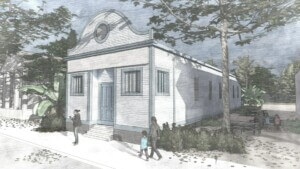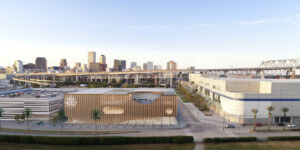New York–based conceptual artist Mary Ellen Carroll will debut her newest project, PUBLIC UTILITY 2.0, at New Orleans’ contemporary art biennial, Prospect.3 in Fall 2014. In it, she identifies communities across New Orleans that remain choked for resources since Hurricane Katrina ravaged the city in 2005. Responding foremost to the lack of connectivity in these areas, Carroll is utilizing unoccupied TV channels, cultural motifs, and an innovative wireless technology developed at Rice University in Houston, Texas, to create infrastructure that will become a permanent characteristic of The Crescent City.
PUBLIC UTILITY 2.0 will consist of two broadband Internet broadcast towers built in sections of the city that will then connect to hubs. The locations of the hubs will be distributed throughout greater New Orleans based on crowd sourcing. By using Internet broadcast towers, Carroll hopes to reimagine traditional city planning by prioritizing what she calls “the elevation plan and broadcast spectrum.” In doing so, physical location will have little correlation with lack of connectivity of under-resourced communities.
A key motivator of PUBLIC UTILITY 2.0 is its potential impact on a national policy debate about the scheduled auction of airwaves for wireless broadband in 2014 by the Federal Communications Commission. Carroll compares the government selling the unused television spectrum to selling public land.
The technology that empowers PUBLIC UTILITY 2.0 is in the developmental stages in Rice University’s Wireless Network Group, led by professor Edward Knightly. The group is experimenting with launching residential broadband Internet service through “TV white space” or TVWS. The service will function like a WiFi hotspot, though it differs in that TVWS emits “lower-frequency TV signals [that] penetrate walls and propagate over distances, meaning it can serve a larger population. The latest TVWS technology released by Knightly’s team earlier this week is estimated to reach a range of about 1 1/4 miles.
Carroll hopes PUBLIC UTILITY 2.0 will reach beyond New Orleans to become a template that other U.S. cities can utilize. She envisions the broadcast towers becoming cultural symbols similar to Moscow’s Shukhov Tower, LA’s Watts Tower, or the RKO transmitter. “The towers would be the visible presence in the city, and the connections they provide would create a cultural, economic, and social platform for greater New Orleans,” she said.










